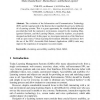430 search results - page 33 / 86 » Power of peripheral designers: how users learn to design |
HCI
2009
13 years 6 months ago
2009
The evolution of the Information and Communication Technology (ICT) and the rapid growth of the Internet have impelled the pervasive diffusion of e-Learning systems. This is a grea...
AAAI
1994
13 years 10 months ago
1994
One of the original motivations for research in qualitative physics was the development of intelligent tutoring systems and learning environments for physical domains and complex ...
CHI
2008
ACM
14 years 9 months ago
2008
ACM
Because most animation tools are complex and timeconsuming to learn and use, most animations today are created by experts. To help novices create a wide range of animations quickl...
ASSETS
2007
ACM
14 years 22 days ago
2007
ACM
Mobile phones can provide a number of benefits to older people. However, most mobile phone designs and form factors are targeted at younger people and middle-aged adults. To infor...
ISWC
2003
IEEE
14 years 2 months ago
2003
IEEE
Context-aware computing describes the situation where a wearable / mobile computer is aware of its user’s state and surroundings and modifies its behavior based on this informat...

